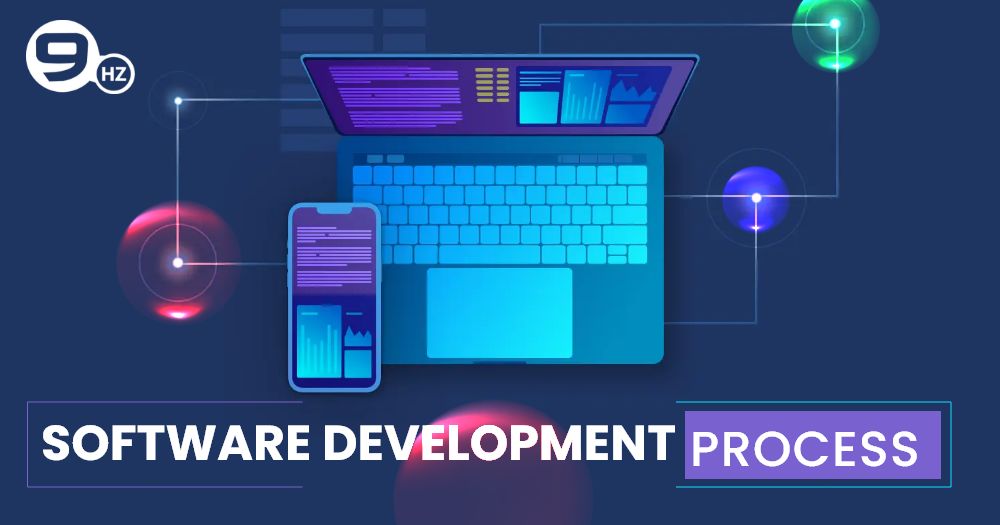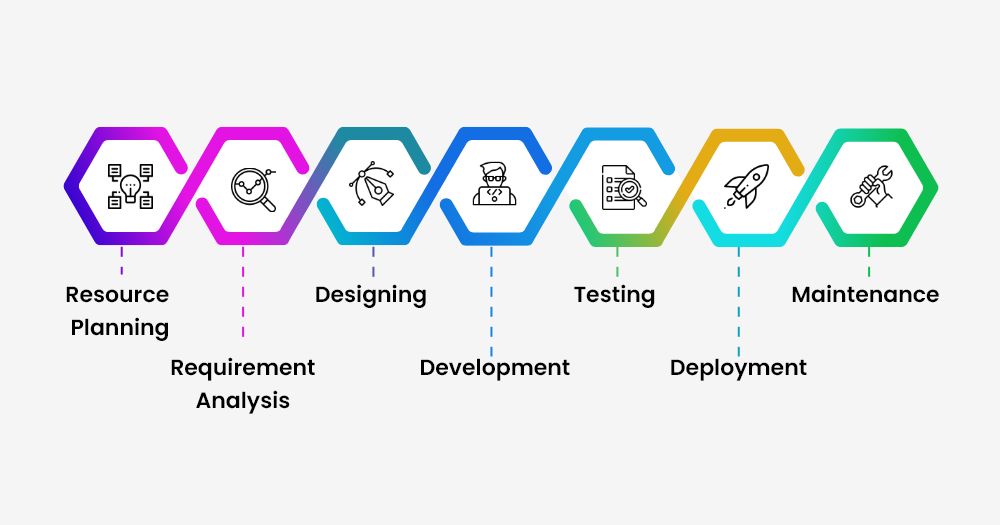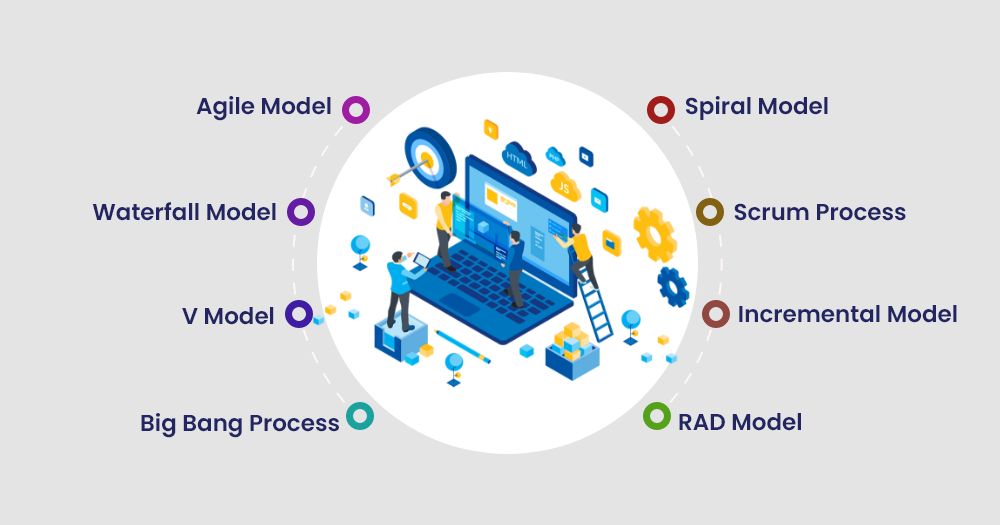Little does everyone knows that software development is a practice where the developers perform some coding and outputs software to perform the task. However, only a fraction of them are aware of the plethora of steps that complete a software development process.
While technology is getting advanced, the market is flooded with different types of software, ready to steal the users. In such a landscape, building effective software requires a definitive software development process that helps foster perfection in each stage to bring the best output. There are different stages of software development that contribute to an effective development life cycle.
If you are also planning to develop software, this blog will talk all about the software development process that you should take care of. You can hire software development services for your product development.
What is the Software Development Process?
Software Development Lifecycle or Process is basically the combination of different development stages to combine and produce high-quality software in the least amount of time. Each stage of this process is dedicated to ensuring different important aspects of the development lifecycle. For example, the first stage helps to generate a vision while another stage makes sure to match the final product to that vision.
The software development process steps have revolutionized over time according to market demands and changing technology scenarios. Similarly, the nature of the project is also a big determinant of the development process as a small project requires less planning while a complex project might demand a huge amount of analysis. Generally, a development process begins with a software idea and completes with the deployment.
7 Stages of Software Development Process
While the number of stages in software development process can differ from company to company and project to project, the 7 steps defined in this guide cover everything from inception to execution. All the stages of the project development life cycle need different roles and expertise to carry out the tasks and assemble the different constituents to build a software product. Let’s dive into these stages to attain a clear understanding of the whole process of software development.
1. Resource Planning
This is the foremost stage of the software development life cycle where the entire communication between the client and development entity takes place. As the name suggests, resource planning helps to figure out all the resources which includes mechanical tools, budget, human workforce, external support, etc. that will be required to complete the project.
First of all, the clients tell us about the kind of software they want to develop. It is one of the crucial phases as the development team figures out if the project falls under their expertise or not. Further, the purpose behind the project and the vision of development are discussed so that both parties can attain a better understanding of the project. Once the firm has figured out the requirements of the project, the planning for cost, procurement, scheduling, and blueprinting begins.
A mutual budget is determined along with the way of payment. Also, the engagement model is also decided in this phase only. The firm provides the price distribution details to the client to justify the budget. At the same time, different roles and team members that will be working on the project are invited for induction. A communication method to provide updates is also finalized in this session.
2. Requirement Analysis
In this stage of the software development lifecycle, the software development team brainstorms about shaping the product. It includes talking about the overall features, and functionalities to deliver the expected outcomes. The stage takes care of all the requirements for designing the prototype. It also talks about the different alternatives that can be utilized for the existing prototypes.
At the same time, this is the phase where the developers create an SRS (Software Requirement Specification) document. This document holds all the information about software, hardware, and network requirements that will be needed to build the software and thus helps to prevent the overdrawing of funding. Moreover, it also allocates resources to different teams and team members so that efficient utilization of resources can be ensured.
3. Designing and Prototyping
This is the third stage of software development process where the UI/UX designers build the interfaces and different portals of the software. The process is known as preparing the prototype. This prototype consists overall appearance of software with chosen themes, colors, elements, buttons, and transitions. At the same time, navigation throughout the software is also instilled in the prototype to some extent.
This prototype is the first deliverable to the client so that they can analyze the functionality, appearance, and functions of the software. It is a good way to collect feedback from clients and implement them in the earlier stage. The core development starts when the prototype has been accepted by the client. So, it can be a really time taking and cost-affecting decision.
4. Software Development
Software Development is the most important stage of the whole development lifecycle where the core coding of the software takes place. The software development process consists of majorly front-end and back-end development. Front-end development refers to constituting the screen to instill it for user interaction. All the screens, buttons, and pages that we see in a particular software are called front-end development. Similarly, the backend is the process where the developer builds the functionality that helps a particular button or click to execute the functions.
There are different technologies that are used by the developers as tech stacks for the software. The choice of technology entirely depends on the type of software and features that the client demands. Similarly, the software development phase also consists of the integration of necessary APIs, third-party supports, and instilling the of payment gateways.
5. Testing
As the name declares, this is the step where the software development team tests the software before deploying it on the marketplace or system. This process is to make sure that software doesn’t carry any bugs or errors, execute all the functions, and work smoothly as expected. For the same, different types of testing are conducted.
Speed testing is one of the numerous tests where the quality analysis team tests the speed of software. Undoubtedly, if the functions are loading slowly, it will ruin the user experience and lower the usability. At the same time, load time is also checked, if the software is taking too much time to load, necessary improvements are executed.
Similarly, unit testing is conducted to identify and remove several bugs from the system to ensure an efficient experience. While bugs totally can not be eliminated, this testing removes all the possible bugs at the time to execute the proper functioning. Integration testing makes sure all the components of the software are functioning properly with each other.
6. Deployment
If you not opting for post-maintenance in your software development projects, deployment is the final development stage of your software development lifecycle. In this step, the software development team deploys the software on the respective marketplace to make it available for end-users. If the software is in the shape of an application, it will be deployed to app marketplaces like Apple App Store or Google Play Store. Here, the team has to ensure that they are complying with all the rules and regulations set by the respective marketplaces to deploy the software. Similarly, the fee is also paid (which is $25 for Google Play Store and $99/year for Apple App Store) during deployment of the software.
If the software is in the shape of an internal tool for any enterprise, it is installed in the Local network of the enterprise so that all the stakeholders of the organization can work collaboratively using the software.
7. Maintenance and after-support
Every software requires aftercare and improvement to keep functioning properly. Deploying the software on the respective platform or system is not all but debugging the errors, adding and removing the features, and providing timely updates are very necessary so that software keeps executing the functionalities. Similarly, there might be issues with the software that can be identified and reported by the end users. This is a very common scenario in which the end user reports the problem to the owner. After maintenance plays a significant role in entertaining this feedback and making the necessary changes.
Pros and Cons of Working with Software Development Life Cycle
Just like two faces of a coin, there are not only advantages and upper sides to using a dedicated software development process. Teams working on development projects have to go through a lot of challenges when working with a predefined process of development. So, here are some of the pros and cons of working with the software development life cycle–
Pros of Software Development Processes
- The process provides a clear vision for the entire project including the team that will be working, the approximate cost of the project and the expected timeline.
- It allows the project stakeholders to take informed decisions according to predefined planning.
- Goals set at the beginning of the project enable the team to work collaboratively while boosting understanding
- All the steps are defined and thus the developers can go back to the previous stage to make the corrections or improvements
Cons of Software Development Processes
- Determining the vision and all the steps of the process might not work all the time as slight complexity in any part of the project can hinder the overall performance and thus result in increased cost or timeframe.
- Most of the development processes and models are not flexible in nature.
- Cost evaluation at the beginning of the project is not always effective as unforeseen factors can affect the budget
- Testing at the end of the project might result in big errors and require the development team to take more time
Most Common Software Development Models
While most software development companies follow the same defined steps for software development, there are different models that firms use to execute these steps. Software Process models are like different methodologies that companies use in their development process. Let’s have a look at different software process models, their core competencies along with downside you should be aware of.
1. Agile Model
Agile software development methodology is one of the most popular development models, used widely in renowned IT companies around the world. The working principle of this model believes in breaking down the whole process into smaller parts called iterations. The benefit of using this approach is that developers can make the changes in each iteration without impacting any other operational stage and hindering cost or time on a large scale.
So, when working with the agile project management methodology, the software development company implements changes as soon as any problem is identified rather than waiting for the final stage to solve it. Here are some advantages of disadvantages of using the Agile Model-
| Advantages | Disadvantages |
|---|---|
|
|
2. Waterfall Model
This is one of the oldest software development models being used by companies. The Waterfall Model works on the simple principle that requires the development team to complete one phase efficiently before moving to the next phase. Only when the phase is completed and there is not potential room for improvement, software development cycle is moved to the next phase. This way, every stage carries information from its previous stage, minimizing the chances of errors. However, using the waterfall models can cause premature delays in the project and even bigger challenges for the development team at later stages.
| Advantages | Disadvantages |
|---|---|
|
|
3. V Model
V Model, also popular as verification or validation mode, is quite identical to that of the Waterfall model. The vision behind this software development process model was to eliminate the drawbacks of the waterfall model to some extent. The biggest limitation previous model is that it lacks frequent testing. So, V Model follows the same step-by-step approach to proceed with the different phases, however, testing is ensured in each of these phases to instantly catch the bugs and make the improvements.
| Advantages | Disadvantages |
|---|---|
|
|
4. Big Bang Process
Many of the clients don’t have clarity about the product they need or want. So, the Big Bang theory allows to take an approach that is highly flexible and can be altered with time. Basically, the development team starts the project with money and resources while not focusing much on advanced planning with a rigorous process. The output might or might not match the client’s vision and thus the changes are implemented according.
Due to high volatility, this approach is used by the project managers only for small projects or experiments which doesn’t impact the operations of owners to a large extent.
| Advantages | Disadvantages |
|---|---|
|
|
5. Spiral Model
As the name suggests, this is a methodology in which the software development project passes through four main stages repeatedly in a spiral motion. This model is meant for bigger projects where it becomes easy for the development teams to build customized products as well as foster any feedback received during the whole software development lifecycle.
The core benefit of using the spiral model in project development is that it ensures better risk management. According to the working principle of the spiral model, the team analyses the potential risks at the beginning of every phase and takes the necessary steps to eliminate the chances of errors.
| Advantages | Disadvantages |
|---|---|
|
|
6. Scrum Process
Scrum is very similar to agile methodology, however, carry a slight difference. The Scrum process consists of several sprints (short phases) with a limited duration of 2 weeks. Each sprint is dedicated to completing a particular development stage of the overall project. The development team decides on the part of a project that will be completed in the sprint, starts with the planning, and reaches execution. The priority of the tasks is determined by the product owner.
| Advantages | Disadvantages |
|---|---|
|
|
7. Incremental Model
The incremental model believes in splitting the software development project into repeated stages where the different versions of the software are launched separately, following the same steps. Here the customer and project managers determine the features and functionalities of each version and ensure the four steps of analysis, designing, coding, and testing, to complete the project. Each new iteration helps the development team to understand even clearly about the project.
| Advantages | Disadvantages |
|---|---|
|
|
8. RAD Model
RAD stands for Rapid Application Development. The approach focuses on developing the different prototypes and models of a software product. Then all the parts are integrated together to build a full-fledged working software. The development team implements the required changes according to the client’s preferences which can be executed much more quickly. Pre-planning the whole process is not critical in the RAD model.
| Advantages | Disadvantages |
|---|---|
|
|
Conclusion
Proceeding with a definite software development process can be a good idea as it keeps telling you about the next step every time a stage is completed. Further, getting an idea about the resource requirements, cost of development, timeline, possible challenges, and mitigations are also some of the biggest advantages one leverage with a software development process. Moreover, implementing the particular model makes the process even more planned as different models provide room for improvements and make the overall procedure more managed.
FAQ’s
1. What Do You Mean by Software Development Life Cycle?
Software Development Life Cycle (SDLC) is basically a process that carries out different stages of software development. Each of these stages is dedicated to achieving a development milestone for a digital product.
2. What are the 7 Stages of the Software Development Process?
7 Stages of the software development process are-
- Resource planning
- Requirements analysis
- Designing and Prototyping
- Software Development
- Testing
- Deployment
- Maintenance and After-Support
3. Which is the Most Used Software Development Model or Methodology?
While Agile Model is among the most used methodologies for the software development process due to its core competencies, the waterfall model and scrum method are also used by numerous IT companies.
4. How Do I Choose a Software Development Model?
you can rely on different factors like criteria, needs, vision, and size of the project to choose the right software development model for your project.
Great Together!












